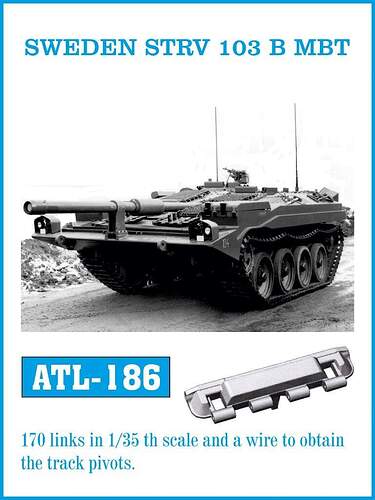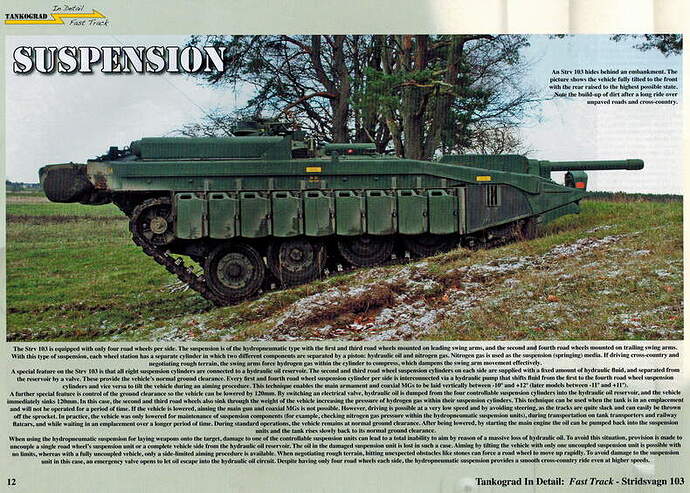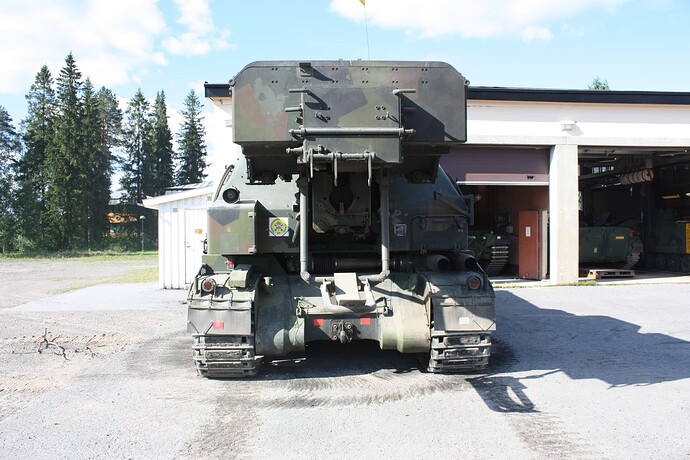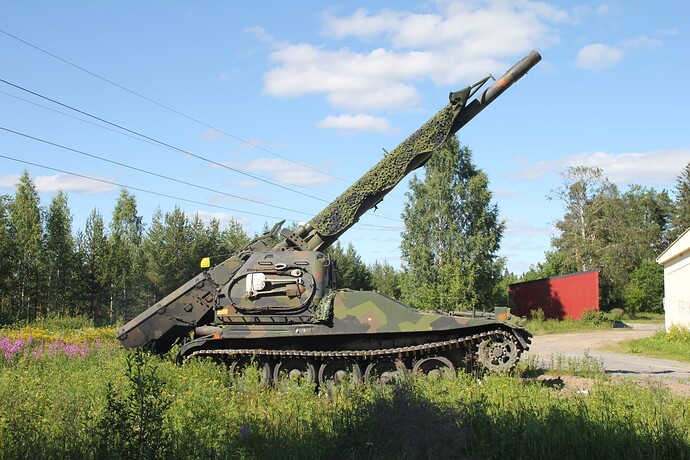I was wondering if any boxing of the kit allows for the barrel to be lowered and built that way?
The Strv 103 barrel was fixed; it had no elevation or traverse capabilities and the vehicle itself was used to lay the gun on target.
If you are asking if the entire tank can be raised/lowered as per the real vehicle that used hydropneumatic suspension to adjust its height and gun elevation/depression, then yes, the Trumpeter kits have separate suspension arms that would allow you to position them how you want. They don’t specifically give you any instructions to do it, but it is relatively simple. You might ned to get individual link tracks as the one piece vinyl tracks may or may not work well with adjusted suspension.
Thanks
Thats what I meant; using the hydropneumatic suspension to adjust its height and gun elevation/depression. I plan on using metal tracks so hopefully that’ll help
Hi!
No reason to use individual track links. The vinyl tracks work fine with an elevated tank. I have done it with the B and the C version. My opinion is that the B version´s steel tracks are not very detailed at all, I would suggest using the Diehl end connector tracks. Don´t know if there are better indy tracks for the B version available in metal. The indy plastic tracks from Trumpeter do not bring any improvement. Same details, only indy. Tankograd Fast Track 20 Strv103 has a real lot of detail pictures of the C version if you are interested.
Andreas
Andreas
RB Model did a nice barrel replacement too:
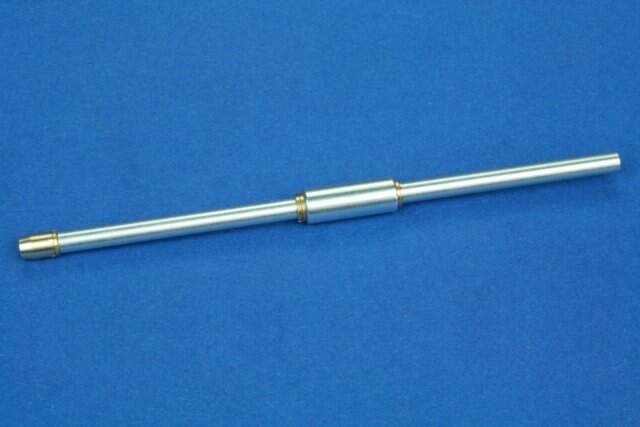
Fruil has a set that seems to have a rubber block in them:
I know little to nothing about the tracks on the vehicle, so I can’t comment on accuracy.
I built mine with the tank/barrel raised. It wasn’t really difficult, just position the suspension arms in the position you want the tank to be. Line them up, and you should be good to go. The kit is in the “closet of unfinishedness”, but sadly, when I looked, the front suspension arms are broken off, so I can’t show you what I did.
Hi!
Here is a nice shot from the Fast Track title.
You can see the vehicle leaning on a dam, leaving close to no shilouette to the enemy. (Picture for discussion only). It is easy to convert, when I remember right, only some small pin have to be removed from the swingarms. When the vehicle is downmost at the front, the blade nearly touches the ground. Leave around 1mm space between on the model. You can also see by the space between the top of the last roadwheel and the underside of the armour how far the rearmost swingarm has to be lowered. Adjust the 2nd and 3rd wheelstation to form a straight line from 1st to 4th. On the real vehicle, 2nd and 3rd wheel station are not operated, they swing by weight of the tilting vehicle due to the fact that all swing arms are connected to a reservoir circuit of fluid. Really interesting design/solution.
The track with the rubber inlay is actually the track of BandKanon1 (which was a heavy self propelled automatically loading artillery piece) and was used at the very beginning of Stvr103A and B. Since most pictures of B version were taken at this time, nearly every B vagn seems to have it. The kit includes a poor replica of the original B version steel tracks. These however are quite near to Centurion design. In the late years of the B vagn, they begun to replace these by Diehl tracks which are quite similar to Leopard 2 Diehl track. C vagns only had these Diehl tracks. Today, not any vehicle with the early steel tracks exist. Some conserved prototyps do have the BandKanon1 track with the rubber pad.
(BKan1 track, seen here from the rear of the vehicle. Track is winter version with incorporated nails in the rubber blocks. A real street surface killer…and a big improvement in Norbottens winter)
Thanks guys!
This has been really helpful
Lovin’ the Bandkanon 1, what an innovative design!
Hi!
For all not familiar with the BKan1 (Bandkanon 1) here it is in firing position. The vehicle was developped parallel to Strv103 and shares components of the running gear. The large structure at the rear is the magazine from which BKan1 fires up to 14 155mm projectiles in 45 seconds automatically!
The weight of 53t (B-version) was impressive too. Only introduced in Swedish Army.
Andreas
Hi!
nice video. A really impressive vehicle, especially for its timeframe. I have only seen it at Kristianstad and at Boden but never in service, only preserved. My picture is the one preserved at Boden. What a pity that all the ammunition is dismantled and therefore it could not be fired at display again. Also, its supply vehicle for the ammunition racks was unique. Not so much the one in the video, but the former one, Lastterrängtruck 611MT.
Andreas
Preserving ammunition is tricky. It can degrade and become really dangerous.
Hi! That´s right. German army has such problem from time to time…but I guess other armies of the world have it, too. Fortunately, a very long time in peace. Until last February…A couple of Demo ammunition shots for loading training of BKan1 is preserved. That never had any explosives in it, built just for handling training.
Could the Leopard 2 tracks be used here for the Strv 103C from Friul model.
yes it can
Great start to this thread since I had no idea what an STRV 103 might be. (Yes I am being critical here.)
You show no example photo nor any explaination of exactly what it is you are talking/questioning about.
However 4-5 posts in, I did finally figure out that you were talking about the unique and unusual SWEEDISH S TANK. Of which I have some very limited, but hands on experience with.
Cannot comment on the tracks as we had only the one example at Knox so nothing to compare it to.
AFV had both ICE and Gas Turbine engines. Can operate the vehicle on just the ICE engine alone when necessary. Has a secondary rear facing aux driver’s station for fast get-aways. Obiviously it has the unique fixed gun whereby the vehicle suspension serves to both elevate and rotate the entire vehicle to aim the gun.
I have zero experience with aiming or firing the gun but since the rotational accruacy of an artillery piece needs to be controlable to the hundredths (or thousandths) of a degree I would suspect this weapon was not very accurate when used as an AT weapon. However I have no direct expierence in this area so I could be totally mistaken.
With engines off and nothing to power the hydralics the vehicle assumes a severe, odd looking, nose down position when parked.
Those who would be able to answer the original question presumably knows what a Strv 103 is.
Robin, I disagree;
#1. My initial criticism is based on basic writting and editorial skills 101 which you as an admin member should have some appreciation for.
#2. I am a prime example of someone who MIGHT just have the answer to the question while still not being aware of the particular nomenclature being used here. We just called it the Sweedish S tank.
p.s. Unless they got rid of it, there should be one example of this AFV under lock & key in the current Benning collection. (And again; it ran when parked.)
The nose down attitude when parking is also extremely convenient when climbing on/off the vehicle.
There were no problems with accuracy when aiming. The aiming was hydrostatic, in principle just as accurate as hydraulic azimut for a traditional turret.
The azimut speed using the whole chassis is equal or greater to the azimut speed for a regular turret.
Some German tank commanders aimed their turret in roughtly the correct direction using the steering and then adjusted with the turret.
Strv 103 could not fire on the move, at least with any precision, but this was not an issue since all other tanks had to stop and aim if they wanted to hit what they shot at.
The current tanks have stabilisation and are able to fire on the move which makes the Strv 103 obsolete.
Still a potent ambush AT-system but thay have all gone to scrap or museums.
